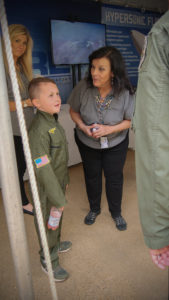AFRL communicates the impact of military technology at DOD Lab Day
ARLINGTON, VA. – Scientists and engineers from the Air Force Research Laboratory displayed advancements in 13 different technology areas at the Department of Defense Lab Day April 25, in the Pentagon center courtyard.
This biennial event highlights the innovative research and development work led by groups within the Defense Laboratory Enterprise, which includes defense laboratories, warfare centers and engineering centers. Technology exhibitors included the U.S. Army, the Navy, the Air Force and the medical community, while other groups promoted educational initiatives and scholarship opportunities. AFRL employees presented various technologies that address current and future military needs to attendees, which included Pentagon employees, members of Congress, Congressional staffers, members of the media and STEM students.
DOD Lab Day supports various agendas. The event provides scientists and engineers with the opportunity to interact with senior leadership; it encourages collaboration between the services, allows the services to promote new technologies and connects these technologies with potential customers.
Air Force Chief Scientist Dr. Richard Joseph stopped by the Pentagon center courtyard to learn more about AFRL technologies. When asked about the biggest challenge that our nation faces, Dr. Joseph cited “complacency” as an issue that must be addressed by the scientific and technical (S&T) community.
“We can never assume that all we have to do is fix next year’s problems and then we’re alright,” he said. “We need to always be thinking about where we are going to be in 10, 15 or 20 years, and that’s what this [event] is all about,” he explained.
Joseph emphasized the importance of “the response of the S&T [scientific and technical] community.” He commended DOD Lab Day’s focus on “communicating the impact of technology to the operators.”
The location is key since “it brings science and technology right into the home of the operator,” he affirmed.
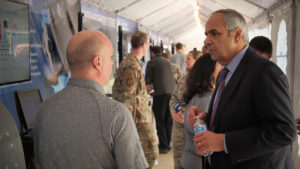
A number of other senior-level leaders from across the country attended the event.
Col. Gary Haase, the director of AFRL’s Munitions Directorate at Eglin Air Force Base, Fla., said that it’s “important [for AFRL] to showcase technologies to get the word out to the larger DOD community. Technology is an important aspect of who we are as the Air Force,” he affirmed. “Since our goal is to stay on the cutting edge of technology, we must show that connection and relevancy to future capabilities.”
The featured technologies represent various stages of maturity spanning the full spectrum of research, development and application. AFRL’s display included one technology that will soon transition to a funded program, one that provides a new service capability in response to an approved DOD need.
Capt. Blake McCollum, an AFRL engineer, says that AgilePod™, an interchangeable system that enables fast, easy connection of sensors to aircraft, “could be a standard not just for the Air Force but for the DOD as well,” and this event could “create a new pathway for that to happen.” McCollum has firsthand experience interacting with the other military branches. During the event, his father, Vice Adm. Luke McCollum, stopped by to show his support.
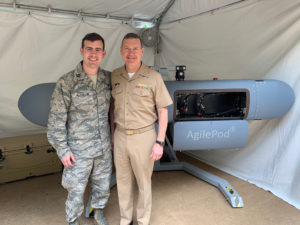
Jeffrey Stanley, the deputy assistant secretary of the Air Force for science, technology and engineering, acquisition and logistics, explained that these types of events highlight “the breadth and the depth of the technical expertise at AFRL.” He thinks that several of the AFRL technologies [presented at DOD Lab Day] have the ability to transition.
“We’ve got a lot of great ideas,” he said, adding that, “we’re always balancing funds between the current readiness of the Air Force, and the future Air Force we need.”

Dr. Michael Griffin, the undersecretary of defense for research and engineering, echoed this sentiment and reinforced the purpose of the Defense Laboratory Enterprise.
“We need to remember that our goal is always, ultimately, mission impact. Our customer is the American warfighter,” he said.

Developing technology for use across the DOD was a common topic of discussion among exhibitors and attendees.
While presenting the Secure, Live Advanced Technology Environment (SLATE), Lt. Col. Ross Uhler said he was excited to “demonstrate a much-needed capability that spans across all of the services.” He explained that SLATE benefits all warfighters since various communities can “tap into this Live, Virtual Constructive framework for large-scale training events.”
SLATE connects live aircraft sensors with virtual and constructive data in a secure and realistic combat environment. This cost-effective, realistic approach supports training gaps for air, land, space, multiservice and multi-national users.
“The military has been talking about operating in a joint realm for ,” said Uhler. “This [represents] a way that we can put all [our] assets in the same training environment.”
Haase said he appreciated the opportunity to interface with folks across AFRL and the DOD. He enjoyed learning about the activities of the other labs since he strives to identify areas of potential collaboration.
The Pentagon center courtyard, an outdoor venue lined with trees, walkways and rectangular tents, housed the various displays that made up DOD Lab Day. Each of the AFRL technologies showcased had its own backdrop that collectively stretched across the entire length of the 150-foot tent.
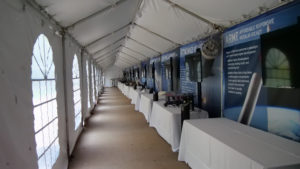
Michael Gudaitis, from AFRL’s Information Directorate at Rome, New York, presented Software Defined Radio, a novel approach that can give [the Air Force] an unprecedented new capability. He asserts that, “unless [the customer] sees a technology and witnesses a demonstration, then they really can’t appreciate how far we’ve come from the old [technology].” This new capability will eventually enable all warfighters to communicate with each other, he said.
1st Lt. Ian Goodbody, also from Rome, explained that “customer knowledge and support is crucial to transitioning technology out of the lab and to the warfighter. These events give us a chance to show off the latest advances in [communications hardware and software], and we can get [the customer] as excited and interested as we are in this product.”
2nd Lt. James Wymer from Kirtland Air Force Base in New Mexico highlighted the capabilities of the [High Power Microwave] System, which utilizes an extremely high power burst of energy to create a variety of effects on a target’s electronics.
“This technology will fundamentally alter the battlefield for our warfighters by giving them a non-kinetic, disrupt and disable capability against enemy electronics,” said Stephen Langdon, AFRL branch chief for HPM.
Dr. Michael Fanto, an AFRL physicist, detailed how quantum science will be a disruptive and groundbreaking technology area for the warfighter.
“We’re solving some of the engineering challenges now, and it’s really exciting,” he said. Quantum science will enhance data encryption and information processing, both of which are critical capabilities for the DOD, Fanto says.
Since the event coincided with Bring Your Child to Work Day, AFRL staff communicated complex information to kids in a way they could relate to and understand. Maj. Elizabeth DeNeve, a program manager for the ESPA Augmented Geosynchronous Laboratory Experiment (EAGLE), asked children to think about the ways they use space on a daily basis, for instance through GPS navigation and communication tools (satellite TV and radio). She used this basic understanding to explain how the Air Force is working to make space more affordable and accessible for future generations.
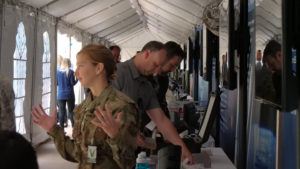
While explaining the mission of the lab, AFRL’s S&T 2030 Business Outreach Lead, Lenell Kern told one boy, “we create the technology that keeps your daddy safe.” As she knelt down, she said, “Our goal is to provide him with the tools that he needs so that he comes home safely to you.” Kern winked, and the boy looked up at his dad with a smile.
